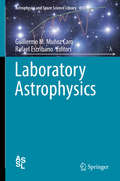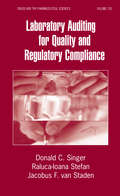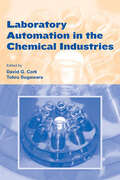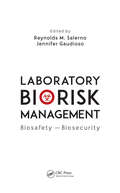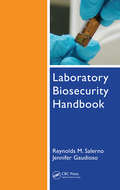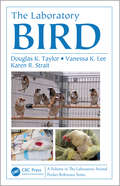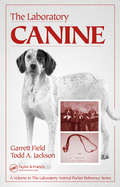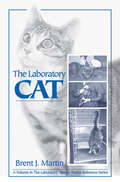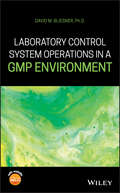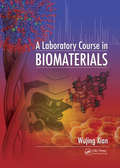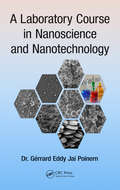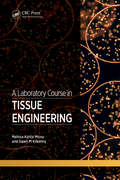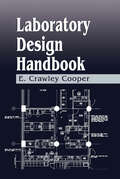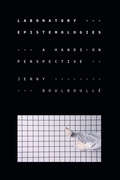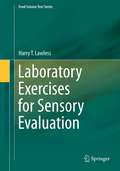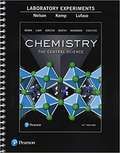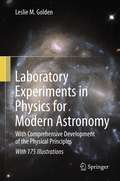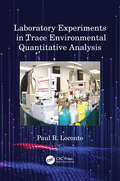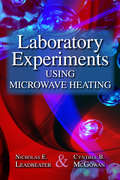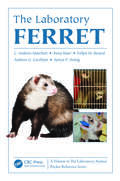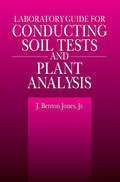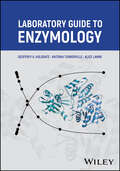- Table View
- List View
Laboratory Astrochemistry
by Thomas Giesen Stephan Schlemmer Harald MutschkeWritten by leading scientists in the field and intended for a broader readership, this is an ideal starting point for an overview of current research and developments. As such, the book covers a broad spectrum of laboratory astrophysics and chemistry, describing recent advances in experiments, as well as theoretical work, including fundamental physics and modeling chemical networks. For researchers as well as students and newcomers to the field.
Laboratory Astrophysics (Astrophysics and Space Science Library #451)
by Rafael Escribano Guillermo M. Muñoz CaroThis book focuses on the most recent, relevant, comprehensive and significant aspects in the well-established multidisciplinary field Laboratory Astrophysics. It focuses on astrophysical environments, which include asteroids, comets, the interstellar medium, and circumstellar and circumplanetary regions. Its scope lies between physics and chemistry, since it explores physical properties of the gas, ice, and dust present in those systems, as well as chemical reactions occurring in the gas phase, the bare dust surface, or in the ice bulk and its surface. Each chapter provides the necessary mathematical background to understand the subject, followed by a case study of the corresponding system. The book provides adequate material to help interpret the observations, or the computer models of astrophysical environments. It introduces and describes the use of spectroscopic tools for laboratory astrophysics. This book is mainly addressed to PhD graduates working in this field or observers and modelers searching for information on ice and dust processes.
Laboratory Auditing for Quality and Regulatory Compliance
by Donald C. Singer Raluca-Ioana Stefan Jacobus F. van StadenIdentifying current tools, techniques, and approaches for the evaluation of laboratory operations, this reference reviews the latest regulatory standards and auditing practices to test laboratory safety, quality, and performance.
Laboratory Automation in the Chemical Indus
by David G. Cork Tohru SugawaraFeaturing extensive calculations and examples, this reference discusses theoretical and practical aspects of short-circuit currents in ac and dc systems, load flow, and harmonic analyses to provide a sound knowledge base for modern computer-based studies that can be utilized in real-world applications. Presenting more than 2300 figures, tables, and equations, the author explores matrix methods for network solutions and includes load flow and optimization techniques. He discusses ac and dc short-circuit systems calculations in accordance with standards set by the American National Standards Institute (ANSI) and the International Electrotechnical Commission (IEC).
Laboratory Biorisk Management: Biosafety and Biosecurity
by Reynolds M. Salerno Jennifer GaudiosoOver the past two decades bioscience facilities worldwide have experienced multiple safety and security incidents, including many notable incidents at so-called "sophisticated facilities" in North America and Western Europe. This demonstrates that a system based solely on biosafety levels and security regulations may not be sufficient.Setting the s
Laboratory Biosecurity Handbook
by Reynolds M. Salerno Jennifer Gaudioso Benjamin H. BrodskyIn recognition of the vital need to protect legitimate facilities from the theft and misuse of dangerous pathogens and toxins, the Laboratory Biosecurity Handbook serves as a guide to the implementation of pathogen protection programs. The first sections of the book offer an historical overview of biological weapons activity, key principles of biosecurity and its integration into existing frameworks, as well as a discussion of biosecurity risk. Later sections discuss biosecurity risk assessments, describe detailed components of a biosecurity program, and offer a graded approach to biosecurity through multiple risk levels. The work also covers risk prioritization of biological assets and biosecurity training.
The Laboratory Bird (Laboratory Animal Pocket Reference)
by Douglas K Taylor Vanessa K Lee Karen R StraitLaboratory animals, including birds, play an important role in biomedical research. The humane care and management of these animals is an ongoing concern. A new addition to the acclaimed Laboratory Animal Pocket Reference series, The Laboratory Bird is the first publication dedicated to the care and use of avian species in the research setting.Cove
The Laboratory Canine (Laboratory Animal Pocket Reference)
by Garrett Field Todd A. JacksonLaboratory animals, including dogs, play an important role in biomedical research and medical advances. Dogs have a long history of use in research and have contributed enormously to the health and welfare of both humans and animals. The humane care and management of these animals is a fundamental component of their use in medical research.T
The Laboratory Cat (Laboratory Animal Pocket Reference)
by Brent J. MartinThis guide was created especially for individuals performing research with cats whose duties include animal facility management, animal husbandry, regulatory compliance, and technical procedures involved with their research. Basic information and common procedures are presented in detail.
Laboratory Control System Operations in a GMP Environment
by David M. BliesnerDevelop an understanding of FDA and global regulatory agency requirements for Laboratory Control System (LCS) operations In Laboratory Control System Operations in a GMP Environment, readers are given the guidance they need to implement a CGMP compliant Laboratory Control System (LCS) that fits within Global Regulatory guidelines. Using the Quality Systems Approach, regulatory agencies like the FDA and the European Medicine Agency have developed a scheme of systems for auditing pharmaceutical manufacturing facilities which includes evaluating the LCS. In this guide, readers learn the fundamental rules for operating a CGMP compliant Laboratory Control System. Designed to help leaders meet regulatory standards and operate more efficiently, the text includes chapters that cover Laboratory Equipment Qualification and Calibration, Laboratory Facilities, Method Validation and Method Transfer, Laboratory Computer Systems, Laboratory Investigations as well as Data Governance and Data Integrity. The text also includes chapters related to Laboratory Managerial and Administrative Systems, Laboratory Documentation Practices and Standard Operating Procedures and General Laboratory Compliance Practices. Additionally, a chapter outlining Stability Program operations is included in the text. In addition to these topics, it includes LCS information and tools such as: ● End of chapter templates, checklists, and LCS guidance to help you follow the required standards ● Electronic versions of each tool so users can use them outside of the text ● An In-depth understanding of what is required by the FDA and other globally significant regulatory authorities for GMP compliant systems For quality assurance professionals working within the pharmaceutical or biopharma industries, this text provides the insight and tools necessary to implement government-defined regulations.
A Laboratory Course in Biomaterials
by Wujing XianThe field of biomedical engineering has vastly expanded in the past two decades, as reflected in the increased number of bioengineering and biomaterials programs at universities. The growth of this area has outpaced the development of laboratory courses that allow students hands-on experience, since the barriers involved in creating multidisciplina
A Laboratory Course in Nanoscience and Nanotechnology
by Gerrard Eddy PoinernAlthough there are many theoretical nanotechnology and nanoscience textbooks available to students, there are relatively few practical laboratory-based books. Filling this need, A Laboratory Course in Nanoscience and Nanotechnology presents a hands-on approach to key synthesis techniques and processes currently used in nanotechnology and nanoscienc
A Laboratory Course in Tissue Engineering
by Melissa Kurtis Micou Dawn KilkennyFilling the need for a lab textbook in this rapidly growing field, A Laboratory Course in Tissue Engineering helps students develop hands-on experience. The book contains fifteen standalone experiments based on both classic tissue-engineering approaches and recent advances in the field. Experiments encompass a set of widely applicable techniques: c
Laboratory Design Handbook
by E. Crawley CooperLaboratory Design Handbook describes the process, motivation, constraints, challenges, opportunities, and specific design data related to the creation of a modern research laboratory. The information presented is based on a large pool of experience in the development of new and renovated laboratory buildings for universities, teaching hospitals, ph
Laboratory Epistemologies: A Hands-On Perspective (Experimental Futures)
by Jenny BoulboulléIn Laboratory Epistemologies: A Hands-On Perspective, Jenny Boulboullé examines the significance of hands-on experiences in contemporary life sciences laboratories. Addressing the relationship between contemplation and manipulation in epistemology, Boulboullé combines participant observations in molecular genetics labs and microbiological cleanrooms with a longue durée study of the history and philosophy of science. She radically rereads Descartes’s key epistemological text Meditations on First Philosophy, reframing the philosopher as a hands-on knowledge maker. With this reading, Boulboullé subverts the pervasive modern conception of the disembodied knower and puts the hands-on experimenter at the heart of life sciences research. In so doing, she contributes a theoretical model for understanding how life processes on cellular and molecular levels are manually produced in today’s techno-scientific spaces. By reassessing the Cartesian legacy and arguing that epistemology should be grounded in the standpoint of a hands-on practitioner, Boulboullé offers the philosophical and historical foundation to understand and study contemporary life sciences research as multisensory embodied practices.
Laboratory Exercises for Sensory Evaluation
by Harry T. LawlessLaboratory exercises are a necessary part of science education. They enable students to better understand the principles discussed in lectures, and provide them with hands-on experience of the practical aspects of scientific research. The purpose of this book is to provide students and instructors with a time-tested set of lab exercises that illustrate the common sensory tests and/or sensory principles used in evaluation of foods, beverages and consumer products. The appendices will also include a set of simple problem sets that can be used to teach and reinforce basic statistical tests. Approximately twenty years ago the Sensory Evaluation Division of the Institute of Food Technologists sponsored the preparation of a set of exercises titled "Guidelines for Laboratory Exercises for a Course in Sensory Evaluation of Foods," edited by one of the co-authors (Heymann). This book will provide additional materials from the second author (Lawless), as well as other instructors, in a uniform format that can be easily adopted for course use. Most importantly, the lab exercises will complement the flagship textbook in the field, Sensory Evaluation of Foods: Principles and Practices, 2E, also by Lawless and Heymann and published by Springer. Possible course adoption of the main text along with the lab manual should enhance the sales of these materials.
Laboratory Experiments Chemistry: The Central Science
by John H. Nelson Kenneth C. Kemp Michael LufasoThis manual contains 43 finely tuned experiments chosen to introduce basic lab techniques and to illustrate core chemical principles. In the 14th Edition, all experiments were carefully edited for accuracy, safety, and cost. Pre-labs and questions were revised and new experiments added concerning solutions, polymers, and hydrates. Each of the experiments is self-contained, with sufficient background material, to conduct and understand the experiment. Each has a pedagogical objective to exemplify one or more specific principles. <P><P> Because the experiments are self-contained, they may be undertaken in any order, although the authors have found in their General Chemistry course that the sequence of Experiments 1 through 7 provides the firmest background and introduction. The authors have included pre-lab questions to answer before starting the lab. The questions are designed to help in understanding the experiment, learning how to do the necessary calculations to treat their data, and as an incentive for reading the experiment in advance. These labs can also be customized through Pearson Collections, our custom database program.
Laboratory Experiments in Physics for Modern Astronomy
by Leslie M. GoldenThis book presents experiments which will teach physics relevant to astronomy. The astronomer, as instructor, frequently faces this need when his college or university has no astronomy department and any astronomy course is taught in the physics department. The physicist, as instructor, will find this intellectually appealing when faced with teaching an introductory astronomy course. From these experiments, the student will acquire important analytical tools, learn physics appropriate to astronomy, and experience instrument calibration and the direct gathering and analysis of data. Experiments that can be performed in one laboratory session as well as semester-long observation projects are included.
Laboratory Experiments in Trace Environmental Quantitative Analysis
by Paul R. LocontoLaboratory Experiments in Trace Environmental Quantitative Analysis is a collection of student-tested experiments that introduce important principles that underlie various laboratory techniques in the field of trace environmental organics and inorganics quantitative analysis. It crosses the more traditional academic disciplines of environmental science and analytical chemistry. The text is organized to begin with minimally rigorous session/experiments and increase in rigor as each session/experiment unfolds. Each experiment features learning objectives, expected student outcomes, and suggestions for further study. Additional features include: Students are introduced to the principles and laboratory practice of instrumental analysis (determinative techniques) that are clearly presented. Students are carefully taken through various ways to prepare samples for trace quantitative analysis (sample prep techniques). Safety warnings are listed within each experiment. Students are introduced to all three types of instrument calibration: external, internal and standard addition. Instructors who are responsible for laboratory courses in analytical chemistry with potential application to environmental sample matrices will find this textbook of value. Graduate programs in environmental science and engineering will also greatly benefit from the content.
Laboratory Experiments Using Microwave Heating
by Nicholas E. Leadbeater Cynthia B. McGowanAllowing many chemical reactions to be completed within minutes, microwave heating has revolutionized preparative chemistry. As a result, this technology has been widely adopted in both academic and industrial laboratories. Integrating microwave-assisted chemistry into undergraduate laboratory courses enables students to perform a broader range of
The Laboratory Ferret (Laboratory Animal Pocket Reference)
by C. Andrew Matchett Rena Marr Felipe M. Berard Andrew G. Cawthon Sonya P. SwingLaboratory animals, including ferrets, play an important role in biomedical research and advances. The humane care and management of these animals remains an ongoing concern. Published in color to provide greater clarity to the techniques and concepts discussed, The Laboratory Ferret presents basic information and common procedures in detail to pro
Laboratory Fundamentals of Microbiology (Eleventh Edition)
by Jeffrey C. PommervilleLaboratory Fundamentals of Microbiology
Laboratory Guide for Conducting Soil Tests and Plant Analysis
by Jr., J. JonesWith the help of this guide, you can use obtained test results to evaluate the fertility status of soils and the nutrient element status of plants for crop production purposes. It serves as an instructional manual on the techniques used to perform chemical and physical characteristic tests on soils. Laboratory Guide for Conducting Soil Tests and Pl
Laboratory Guide to Enzymology
by Geoffrey A. Holdgate Antonia Turberville Alice LanneLABORATORY GUIDE TO ENZYMOLOGY An accessible guide to understanding the foundations of enzymology at its application in drug discovery Enzymes are highly specialized proteins necessary for performing specific biochemical reactions essential for life in all organisms. In disease, the functioning of these enzymes can become altered and, therefore, enzymes represent a large class of key targets for drug discovery. In order to successfully target dysfunctional enzymes pharmaceutically, the unique mechanism of each enzyme must be understood through thorough and in-depth kinetic analysis. The topic of enzymology can appear challenging due its interdisciplinary nature combining concepts from biology, chemistry, and mathematics. Laboratory Guide to Enzymology brings together the theory of enzymology and associated lab-based work to offer a practical, accessible guide encompassing all three scientific disciplines. Beginning with a brief introduction to proteins and enzymes, the book slowly immerses the reader into the foundations of enzymology and how it can be used in drug discovery using modern methods of experimentation. The result is a detailed but highly readable volume detailing the basis of drug discovery research. Laboratory Guide to Enzymology readers will also find: Descriptions of key concepts in enzymology Examples of drugs targeting different enzymes via different mechanisms Detailed discussion about many areas of enzymology such as binding and steady-state kinetics, assay development, and enzyme inhibition and activation Laboratory Guide to Enzymology is ideal for all pharmaceutical and biomedical researchers working in enzymology and assay development, as well as advanced students in the biochemical or biomedical sciences looking to develop a working knowledge of this field of research.
Laboratory Guide to Human Physiology: Concepts and Clinical Applications
by Stuart Ira FoxThe seventh edition of this laboratory guide, like the previous editions, is a "stand-alone" human physiology manual that can be used in conjunction with any human physiology textbook. It includes a wide variety of exercises that support most areas covered in a human physiology course, thus affording instructors the flexibility to choose those exercises best suited to meet their particular instructional goals. Background information that is needed to understand the principles and significance of each exercise is presented in a concise manner, so that little or no support is needed from the lecture text. <p><p> The lecture and laboratory segments of the human physiology course, however, are most effectively wedded when they cover topics in a similar manner and sequence. Thus, this laboratory guide is best used in conjunction with my textbook, Human Physiology, fifth edition (Wm. C. Brown Publishers, 1996). <p> The laboratory experiences provided by this guide allow students to become familiar--in an intimate way that cannot be achieved by lecture and text alone--with many fundamental concepts of physiology. In addition to providing hands-on experience in applying physiological concepts, the laboratory sessions allow students to interact with the subject matter, other students, and the instructor in a personal, less formal way. Active learning is required to perform the exercises and to complete the laboratory report at the end of each exercise.

